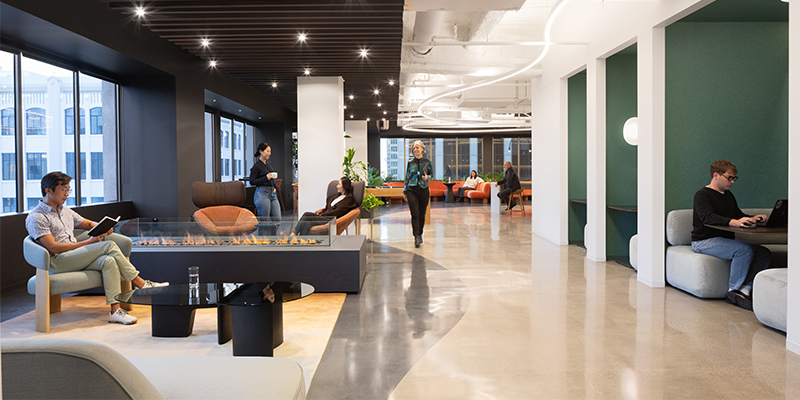An expert panel at CRE.Converge this week led by Trent Agnew, SIOR, senior managing director, JLL Capital Markets, examined what’s happening in the capital markets across property types and regions, shared their predictions for 2025 transaction activity, changes in the lender pool, the latest approaches to asset allocation and more.
Agnew was joined by Laura Hyde, managing director, investments, Link Logistics Real Estate; Kevin Jones, director, Pacific Life Insurance Company; and Bob Ybarra, executive vice president, CBRE.
What does the Fed’s recent interest rate cut mean for you as you look at the balance of 2024 and into 2025?
“I think the interesting thing about the rate cut is that it didn’t really change anything – it was already priced into the market, largely speaking,” said Hyde. “What it did impact was sentiment.”
There is currently $105 billion of uncommitted equity in North American real estate funds, she added, with roughly 40% allocated to industrial, the majority of which are targeting value-add returns. With so few deals on the market that meet the value-add profile, “It’s a bit of a feeding frenzy.”
Jones agreed, saying, “The period of uncertainty has finally come to an end, and we’re going through this reduction cycle signaling to all these folks that, hey, it’s time to get back in the market.” A poll he saw recently stated that 35% of investors in 2025 are going to be net sellers. “You’ve got this backlog… a ton of dry powder.”
“Working as an intermediary, we’re seeing a significant increase in activity,” said Ybarra. It was really slow going into 2024, but now Ybarra predicts they will do as much or more business in the last four months of the year than they did in the first eight months combined.
What are you and your clients excited about? Concerned about?
There is an unprecedented amount of industrial supply that was absorbed or delivered over the past couple of years, and that’s being actively absorbed, Hyde said. “I’m optimistic that potentially towards the end of next year, we really start to see some material rent growth.”
As far as concerns, Jones shared, “You have a lot of ready-to-go dirt that wasn’t ready to be capitalized in 2023 and 2024 that has the potential to go up at the same time. And if it does, then you we’re putting ourselves back into a supply issue. So that’s one thing that we’re kind of wary of.”
“By and large, what we’re seeing clients ask for is flexibility first,” said Ybarra, adding that a three-to-five-year term paper is very typical right now, so clients can figure out where the market is ultimately going to be, but still have a good exit.
Will we see an uptick in transaction volumes for 2025?
“Oh, we’ll certainly exceed 2023 and 2024,” Jones said. “There are net sellers out there that didn’t get to transact then. Those deals will materialize this year and there’s money to buy it.”
“We have a number of groups reaching out to us that still want to get something done this year,” said Hyde. “They have a ton of allocations for the year that they haven’t used yet… A lot of pent-up capital that is a closed-end fund and has to get out the door.”
She added that she wouldn’t be surprised if, while the first half of the year was a little slow, 2024 ends up in line with 2023.
Ybarra, who is local to Las Vegas, mentioned that when the Western States CREF Conference was in the area recently, he sat down with 50 unique lending sources across the full capital stack.
“I can count on one hand the groups that were really at full-on allocation or going to be full-on allocation. That was just the direct result of not having the business earlier in the year. In fact, one large life insurance company indicated they just got an additional $2 billion of allocation for this year.”
What are some of the first things you look for when potential deals come across your desk?
“The first thing that I look at on any deal is, ‘Am I going to lease this thing, and how quickly am I going to do it?’” said Jones. If it passes that test, then then the deal looks a lot better and has a lot more movement in the investment committee room.
“On the demand side, we look at population growth, consumer spending, GDP outlook… How many tenants are there in the market? But really, it’s can I lease this thing and how quickly am I going to do it?” he added.
When Link looks at new opportunities today, they’re also taking into consideration who’s going to buy it. “Maybe we know that this profile is perfect for XYZ, and we know they’ve got to get capital out the door. Maybe they’re at the end of their fund and we know that they just need to put something in a safe place, investment-wise.” Staying informed about the bidder landscape helps the firm focus.
If you had an unlimited bucket of capital, where would you invest it?
“I’ve been saying it for probably a year – I’m actually long on San Francisco office,” said Jones. “I really do think that it’s a town that you can’t replicate. It’s the center of the universe for tech.” He pointed out that with Amazon staff now back in the office five days per week, other big tech names will likely follow, and guessed that the $100/foot office buildings will be back to $1,000/foot.
“I think for me it’s retail,” said Ybarra. “It’s still a place where you can get some yield in terms of cap rates and in the long term, it’s really showed well, even during COVID.”
“I live in a little industrial bubble,” said Hyde with a laugh. “So, I’m going to stick with what I know. I would be investing in the central region, specifically deals with 5-7-year terms. You’ll see a lot less competition with those specific criteria.”
This post is brought to you by JLL, the social media and conference blog sponsor of NAIOP’s CRE.Converge 2024. Learn more about JLL at www.us.jll.com or www.jll.ca.









